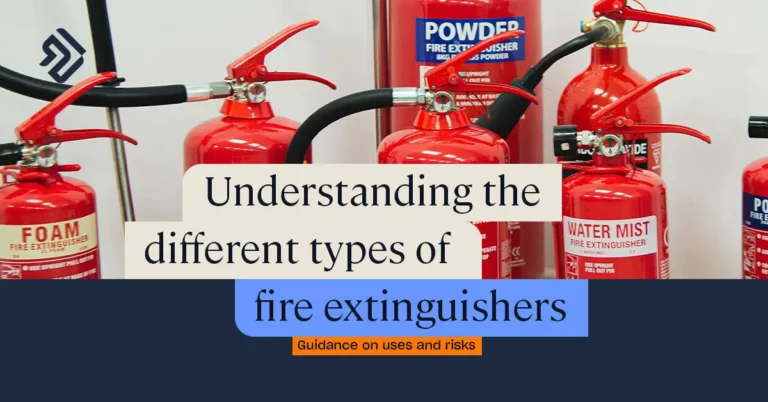Fire extinguishers are vital safety devices in homes, workplaces and public areas. They can significantly reduce the damage caused by fire and even save lives. However, to utilise these devices effectively, understanding different fire extinguisher types and their appropriate uses is crucial.
This guide will help you understand the different types of fire extinguishers available, their applications and the importance of proper training.
Understanding Fire Extinguishers
Fire extinguishers are devices designed to combat small fires by releasing substances that cool the burning material, remove the oxygen or stop the chemical reaction causing the fire. They come in various sizes and types, each suited to fighting different kinds of fires. Knowing how to use a fire extinguisher correctly is a crucial skill everyone should possess.
Classes of Fire
Understanding classes of fire is essential for selecting the correct type of fire extinguisher. These include:
- Class A: Fires involving solid materials such as wood, paper and textiles.
- Class B: Fires fueled by flammable liquids like gasoline, oil, grease and solvents.
- Class C: Fires involving energised electrical equipment such as appliances, wiring and circuit breakers.
- Class D: Fires ignited by combustible metals like magnesium, titanium and sodium.
- Class E: Electrical fires (note that in many regions, electrical fires are not classified separately but are considered part of other classes).
- Class F: Fires involving cooking oils and fats.
Types of Fire Extinguishers
There are several types of fire extinguishers, each designed to fight specific classes of fire, including:
1. Water Extinguishers:
These are prevalent and straightforward, primarily used for Class A fires involving ordinary combustibles such as paper, wood, and textiles. They extinguish fires by cooling the material below its ignition temperature, effectively stopping combustion. Due to their versatility and ease of use, these extinguishers are typically found in various settings, including schools, homes and offices.
2. Foam Extinguishers:
These extinguishers are suitable for Class A and B fires and effective against fires involving flammable liquids like petrol and paint. The foam produced by these extinguishers blankets the burning material, cutting off the fire’s oxygen supply and preventing the release of flammable vapours, making them indispensable in garages, fuel storage areas and workshops.
3. Dry Powder Extinguishers:
Dry powder extinguishers are considered versatile when tackling Class A, B and C fires, making them popular in diverse environments. The powder interrupts the fire’s chemical reaction, quickly knocking down flames. These extinguishers are instrumental in places with mixed fire risks, including vehicles and boats.
4. CO2 Extinguishers:
These are ideal for electrical and Class B fires, distinguished by their non-conductive and non-corrosive extinguishing agents. CO2 extinguishers work by displacing oxygen, effectively suffocating the fire. Because they leave no residue, they are preferred for use on sensitive electronic equipment and in kitchens.
5. Wet Chemical Extinguishers:
Uniquely designed for Class F fires, typically involving cooking oils and fats, these extinguishers use a solution that reacts with the burning oil to form a soap-like film, sealing the surface and preventing re-ignition. These extinguishers are essential in commercial kitchens and food processing plants, where fires are more likely to occur.
Fire Extinguisher Colour Coding or Colour Bands
Fire extinguishers are colour-coded to help users quickly identify the type of extinguisher.
- Red: Signifies water extinguishers, primarily used for class A fires.
- Cream: Represents foam extinguishers, effective against Class A and Class B fires.
- Blue: Denotes dry powder extinguishers, which can tackle Class A, B and C fires, as well as fires involving flammable gases.
- Black: Represents CO2 extinguishers, suitable for Class B and Class C fires.
- Yellow: Denotes chemical extinguishers specifically designed for Class K fires.
These colour codes are usually found on the label or the band at the top of the extinguisher, making it easier to pick the correct extinguisher in an emergency.
Essential Fire Safety Equipment & Training
Knowing fire risks, control measures and fire safety equipment is crucial to ensure fire safety in the workplace.
Through fire awareness courses, individuals gain knowledge of occupational fire risks and safety measures to control them. These courses are suitable for employees at all levels and prepare them for a fire emergency.
It’s essential for organisations to provide fire safety equipment in proper working order such as fire alarms, sprinklers, emergency lighting and fire extinguishers.
Employees should also receive fire extinguisher training to learn about different types of extinguishers, how to use a fire extinguisher and steps to conduct an inspection.
Conclusion
Fire extinguishers are crucial tools for ensuring safety during a fire. By understanding the different types of extinguishers, the classes of fire they are designed to combat and the importance of proper training, individuals can prepare themselves to act decisively and effectively.

